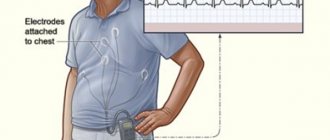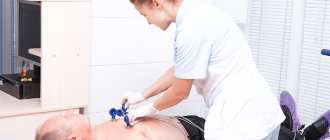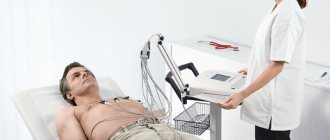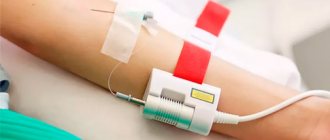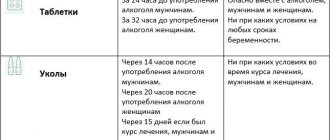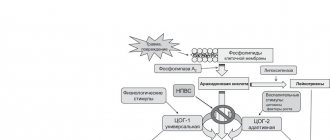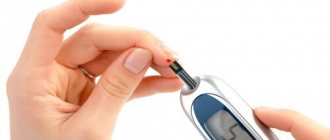Modern diagnostic technologies in medicine make it possible to more efficiently and effectively examine the entire body and find hidden diseases, congenital pathologies and neoplasms that appear throughout a person’s life. Daily ECG monitoring (Holter) or daily Holter recording is a diagnosis that consists of continuous recording of the electrical activity of the heart.
Features of daily ECG monitoring (Holter)
Holter ECG monitoring or Holter ECG appeared in medicine back in the mid-90s. The study consisted of monitoring heart function. The technique and equipment for the procedure were developed by American biophysicist Norman Holter.
Now the Holter ECG is considered one of the most reliable diagnostics for disturbances in the electrical activity of the heart throughout the day, in the conditions of the patient’s usual day and night. A special device is attached to the patient's body, it is called a portable recorder, which continuously records the ECG through electrodes that are placed on the patient's chest.
This diagnosis allows us to detect any cardiac dysfunction. Using the technique, it became possible to timely identify serious pathological changes that could not be detected during a routine examination by a cardiologist or when recording a routine ECG.
Content:
- Features of daily ECG monitoring (Holter)
- What is the difference between a regular ECG and a Holter ECG?
- When is Holter ECG prescribed?
- Types of Holter ECG monitoring
- Stages of preparation for the examination and features of its implementation
- Decoding the results
The patient carries the equipment in a special case. The study will not interfere with your usual lifestyle and will not cause any discomfort or discomfort. The patient should record any changes that occur in his health. The information is recorded on paper, indicating the exact time of the deterioration and the background against which this deterioration occurred.
The main advantages of diagnostics: a modern device records a huge amount of data, the analysis of which will make it possible to make a correct diagnosis; the device will detect any heart pathologies; thanks to the device, it is possible to promptly identify the daily number of rhythm disturbances, the type of rhythm and conduction disturbance, and ischemic signs; Conducting the study under familiar conditions will provide correct and reliable readings of heart function, since this eliminates additional stress.
Individual requirements for a diary
If necessary, the doctor may impose additional requirements for filling out the diary. They are usually based on patient complaints. For example, the doctor may ask to indicate the time of onset of attacks of dizziness, pain in the chest, or the effect of stress on the patient. You may also need to further specify the type of physical activity (for example, active play with children, walking up stairs). Patients who take medication constantly or who drank a drug once during the procedure should record this in a diary. The name of the drug, its dosage and time of administration are indicated.
It is advisable to keep a diary as detailed as possible. More detailed information will help your doctor make an accurate diagnosis.
What is the difference between a regular ECG and a Holter ECG?
If we compare conventional electrocardiography with 24-hour monitoring, the first research method will be less informative and reliable. ECG is a recording of cardiac activity, which is carried out for 15-30 seconds in a state of complete rest. With its help, you can see the electrical processes in the heart, but only in a short period of time.
Standard electrocardiography will not be able to detect hidden cardiac pathologies that do not manifest clinically and are not recorded during recording by the device in resting states, or appear at an unspecified time during the day. As a result of a conventional study, it is impossible to see the functioning of the heart during eating, intense physical activity, sleep and rest.
Also, the correctness of the ECG results can be affected by the patient’s stressful state. This is due to the fact that during stress, phenomena will be present on the cardiogram that can be misinterpreted as pathology. Due to unreliable results, an incorrect diagnosis may be made, then treatment will be ineffective and even dangerous to human health.
Daily monitoring (Holter) will help identify disturbances in the functioning of the heart that are “transient” in nature (coronary heart disease, disturbances in heart rhythm and cardiac conduction). The duration of diagnosis depends on what abnormal and pathological phenomena the attending physician suspects.
To conduct a daily study, a portable recorder is used, which records all cardio readings. Modern devices can record not only cardiac indicators, but also blood pressure, respiratory indicators and others. This technique is allowed even for pregnant women and the elderly. ECG monitoring is indicated for all patients who have detected disturbances or abnormalities in the functioning of the heart.
Indications and contraindications for ABPM
Indications:
- Primary diagnosis of hypertension.
- Monitoring treatment in people with hypertension.
- Obtaining information about the time of day at which the patient’s blood pressure most often increases in order to adjust the doses of drugs received at different times of the day. For example, in patients with high blood pressure at night, it is better to prescribe additional medications at night, and in the morning and daytime, the emphasis is on taking medications in the morning, immediately after waking up,
- Diagnosis of hypertension in individuals with a high level of stressful situations during working hours, when hypertension has a psychogenic cause. Treatment tactics in this case should begin with sedative therapy.
- Sleep apnea syndrome.
- Hypertension in pregnant women, especially with suspected preeclampsia (the study is carried out in a hospital).
- Examination of pregnant women before childbirth if they have hypertension in order to resolve the issue of delivery tactics.
- Examination to confirm professional suitability (train drivers, etc.), as well as for conscripts whose suitability for military service is in doubt.
Contraindications:
- Dermatological diseases associated with damage to the skin of the upper limb - lichen, fungus, etc.
- Blood diseases (thrombocytopenia, hemorrhagic purpura, petechial rash, etc.)
- Upper limb injury.
- Vascular diseases with damage to the arteries and veins of the upper extremities in exacerbation,
- Mental illness of the patient associated with inability to self-care, with aggression.
HBP Clinic invites you to the 24-hour Holter and ABPM monitoring procedure. Make an appointment by phone: 8 (495) 645-45-46.
When is Holter ECG prescribed?
The Holter research method is recommended for people of all ages, including pregnant women. Fainting, dizziness, discomfort in the heart area, attacks of irregular heart function, palpitations, shortness of breath - all these symptoms are subject to daily Holter ECG monitoring.
In relation to the established nosology, this diagnostic procedure is indicated for the following diseases:
- heart defects;
- diseases of the endocrine system;
- obesity;
- acute or chronic heart failure;
- previous myocardial infarction;
- arterial hypertension;
- hypertension that is not amenable to therapeutic treatment.
It is also advisable to do a Holter ECG to monitor the operation of the pacemaker.
Types of Holter ECG monitoring
Nowadays, a 24-hour examination is the best way to conduct a general diagnosis of the body and health status. The survey can be carried out in 2 ways: full-scale and fragmented.
The fragmentary method is used when a person has an arrhythmia. If the patient begins to feel discomfort, pain in the chest, or a general deterioration in health, he presses the button of the device and the recording of cardiac parameters begins.
A full-scale diagnostic method lasts for at least 1 day and maximum 1-2 weeks. An ordinary cardiogram will not provide as complete data as the method of the famous American biophysicist.
The doctor can assign several tasks to the patient, the results of which will be recorded by the device. For example, a patient needs to go up to the 7th floor, then go down. At this time, the recorder will record heart function indicators, which will determine the patient's health status.
Stages of preparation for the examination and features of its implementation
In order for the technique to show reliable results, the patient should prepare for a procedure that will last for 24 hours or 3 or more days. Before the procedure, it is necessary to take a shower, because during the examination the patient must not remove the equipment or wet it with water. You should remove metal jewelry and accessories (watches, earrings, pendants), as metal negatively affects the accuracy of cardio readings. During the procedure, you need to wear comfortable clothes, preferably cotton.
For proper operation of the device, water should not be allowed to get on the equipment; contact of the equipment with other devices that create magnetic fields around them should be avoided. You must carry the recorder carefully so as not to damage its integrity: you must not drop or hit it.
The equipment consists of 2 parts - a stationary decoder and a recording device that takes readings. The electrodes are fixed to the skin.
A full-scale heart study is carried out while the patient leads his usual lifestyle, prepares food, runs, sleeps, eats, and rests. Everything that the patient does during the monitoring process is recorded in the diary. The time spent on a specific action is recorded. You can characterize your condition using three indicators: worsened, improved, or remained unchanged.
Rules and recommendations during a Holter ECG: first, you should not exhaust yourself with physical activity, because there is a risk that the electrodes will detach from the skin and the diagnostic results will be inaccurate: second, the patient should avoid stressful situations; third, it is undesirable to travel, fly on an airplane or go on attractions during the examination; fourth, the device should not be exposed to strong temperature changes; fifth, you should protect the recorder from moisture and water.
The patient should lie on his back so that the location of the electrodes is not disturbed. If your back hurts, you can turn over on your side, but at the same time monitor the operation of the device. This technique is considered safe; it does not cause complications or pathological changes. Cardiac registration should not be prescribed to people with high blood pressure, left ventricular diastolic dysfunction, organ dysfunction, acquired heart defects, asymptomatic myocardial ischemia, angina pectoris (chest discomfort).
Best materials of the month
- Coronaviruses: SARS-CoV-2 (COVID-19)
- Antibiotics for the prevention and treatment of COVID-19: how effective are they?
- The most common "office" diseases
- Does vodka kill coronavirus?
- How to stay alive on our roads?
What should be the daily routine?
The most common one. Medicines should be taken in accordance with the prescription of the attending physician. When you sleep, it is best to do this on your back or right side. Be sure to include in your diary the time you fell asleep and woke up, and describe the quality of your sleep.
What not to do
- wash and bathe (you can only wash your face and brush your teeth);
- Ultrasound;
- physiotherapy,
- massage;
- FGS;
- undergo a tomograph;
- undergo X-ray examinations;
- ride a bike;
- clean the floor;
- do push-ups or exercise;
- lift weights.
What to limit:
- working on a computer;
- talking on a cell phone;
- rides in the elevator;
- riding a tram and trolleybus;
- any load on the shoulder girdle.
Loading your legs is not contraindicated. You can take a walk or go to the store in complete peace.
Be careful not to hit the recorder!

